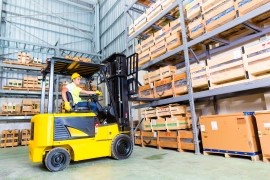Two focuses of my blog are Financial Literacy/Money and Business/Entrepreneurship. No matter which country you are conducting business in, you want to maximize your operations in terms of profits and losses. The following guest post is entitled, Preventing Losses in Singaporean Warehouse Operations.
* * *

• Effective warehouse management in Singapore involves organization, reliable equipment, and robust security measures.
• Regular background checks, efficient inventory management, and automation significantly enhance operation efficiency.
• Seamless integration with other systems, regular quality checks, and modern technology adoption are crucial for loss prevention.
• Staff training and fostering a learning environment are vital for operational success and risk mitigation.
As a business owner, it is quite frustrating to see considerable losses of stocks and products in your warehouse, especially in Singapore, where space is minimal and costs are high. However, you can significantly minimize the losses with the right measures and strategies. This blog post will discuss effective ways to prevent losses in your Singaporean warehouse operations.

Keep Your Warehouse Well-Organized
Properly organizing your warehouse is crucial for fast, efficient, and safe operations. Ensure that every item is correctly labeled and stored in its designated location. Consider using color codes to organize your products and pallets. This will help you locate items quickly, minimize mistakes, and reduce the risk of product damage.
Use Reliable Equipment and Technology
Invest in high-quality warehouse equipment and technology to improve the efficiency of your operations. Consider using tools that are designed to move goods safely and quickly. For instance, you should look for a reliable forklift for sale to move products around the warehouse. You can also invest in a durable pallet racking system to store your products vertically and save on space.
Invest in Robust Security Measures
It is essential to secure your warehouse from unauthorized personnel and theft. Be sure to install CCTV cameras and alarms to monitor and alert you of suspicious activity. Additionally, provide your employees with training on security protocols and encourage them to report any unusual behavior. You may also consider implementing a badge or ID card system to track who enters and leaves your facility.
Conduct Background Checks
Another effective way to secure your warehouse is by conducting background checks on potential employees. This can help weed out individuals with a history of theft or other criminal activities. Regularly reviewing and updating your security measures is also essential to stay ahead of potential threats.
Adopt an Efficient Inventory Management System
A good inventory management system can help you track the movement and location of your products, identify any discrepancies, and even automate some of your warehouse processes. Consider investing in inventory management software, such as SAP or Oracle, to help you streamline operations, reduce manual errors, and provide real-time data on your stock levels.
The Benefits of Automation
Incorporating automation in your inventory management system can be a significant game-changer. Automated systems can continuously monitor stock levels, promptly notifying you when to reorder to prevent stock-outs or overstocking. They can also accurately predict demand trends, allowing you to plan better and reduce wastage.
Integration With Other Systems
An optimized inventory management system should be in collaboration. Instead, it should seamlessly integrate with other systems, such as your accounting software and point of sale system. This integration means data flows automatically between systems, eliminating manual data entry, reducing the chances of error, and ensuring all your systems reflect the same accurate, real-time information.
Implement Regular Quality Checks
Goods can be damaged during transit, storage, or handling, leading to significant losses. To prevent this, inspection and quality checks should be done regularly on incoming and outgoing goods and those stored in the warehouse. Quality checks ensure that damaged products are identified before they are sold or shipped, minimizing the risk of customer complaints and additional costs.
Use Modern Technology for Quality Checks
Embrace the power of technology to make your quality checks more efficient and accurate. Technologies like barcode scanning and Radio Frequency Identification (RFID) can help track goods throughout the process, from delivery to dispatch. They can also be useful in identifying any missing or misplaced items. Furthermore, drones and robots can inspect hard-to-reach places and significantly reduce the time taken for the checks.

Train Your Staff
Your staff is the backbone of your warehouse operations. Ensure that they are adequately trained on handling and storing your products properly. Provide them with safety training on how to operate the equipment safely, including pallet jacks and forklifts. You may consider hiring a professional training company to provide regular training programs for your employees.
Foster a Learning Environment
Encourage a culture of continuous learning within your warehouse operations. Regularly update your staff on changes in operational guidelines, industry best practices, or occupational health and safety regulations. You can consider organizing workshops, seminars, or team-building activities to facilitate knowledge-sharing and peer-to-peer learning. The more informed your staff is, the better they will be at identifying and mitigating potential risks.
Warehouse operations can be challenging, but with the right measures, you can significantly prevent losses from your Singaporean warehouse operations. Keep your warehouse well organized, adopt a robust security system, invest in an efficient inventory management system, conduct regular quality checks, and train your staff. These steps will minimize the risk of losses and improve overall efficiency, saving you money and headaches.
